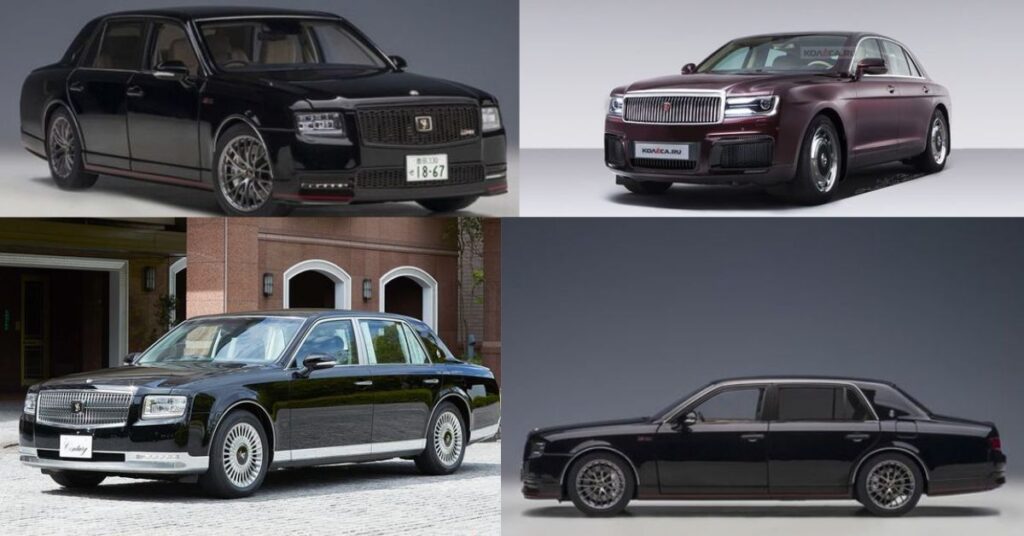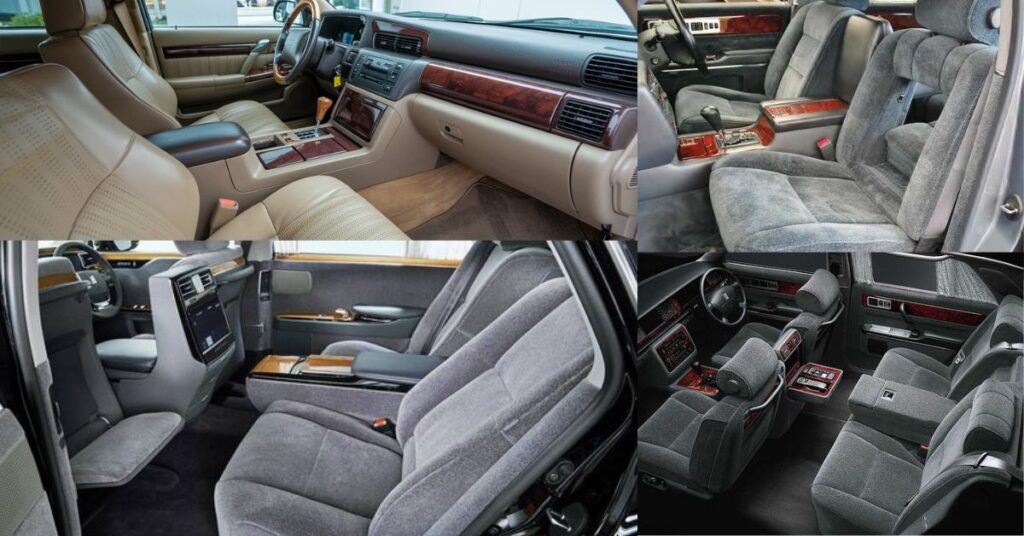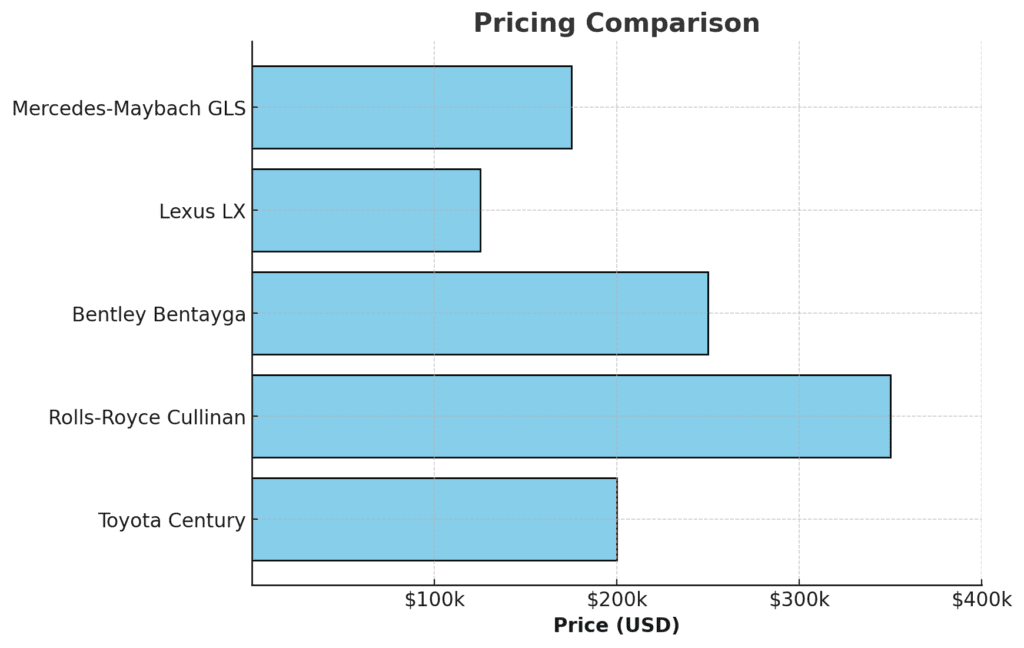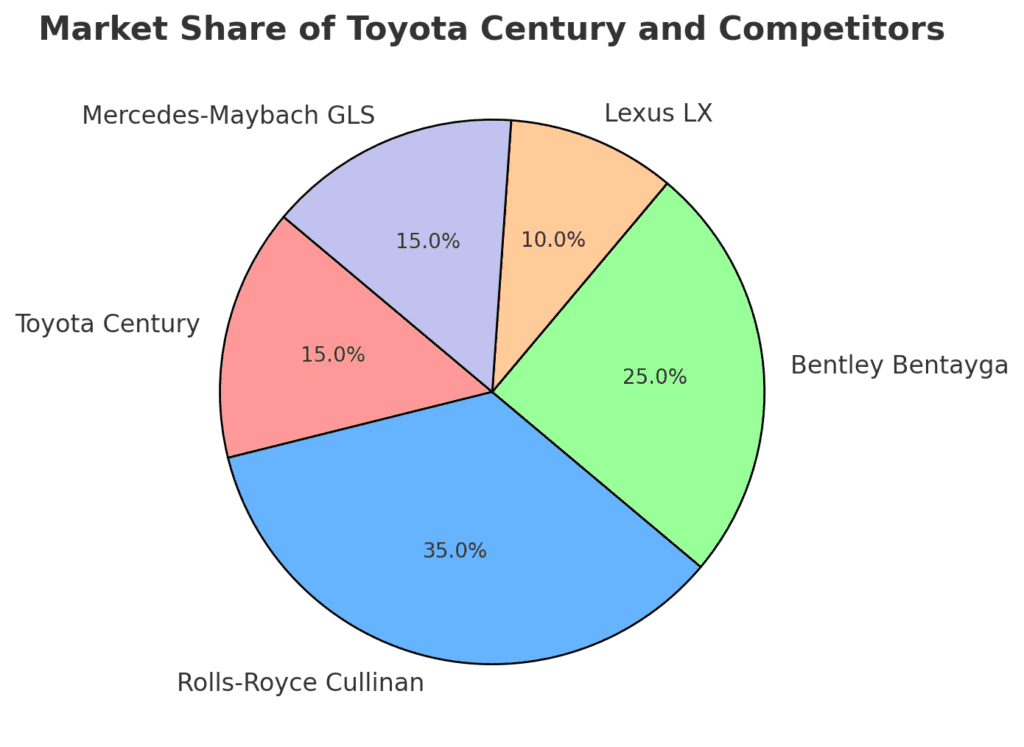Introduction
In the high-stakes world of luxury cars, where prestige and sophistication reign supreme, few vehicles embody these qualities like the Toyota Century. Known as Japan’s ultimate luxury sedan, the Century represents a quiet yet profound dedication to over-engineering and exclusivity, prioritizing craftsmanship and subtlety over flash. The Toyota Century isn’t just a car—it’s a masterpiece that epitomizes Japanese values of precision, respect, and dedication to excellence.
Released in 1967, the Toyota Century was crafted with the intention of being Japan’s answer to Western luxury brands like Rolls-Royce and Bentley. Since then, it has developed a reputation that transcends the boundaries of typical luxury. Built almost entirely by hand, the Century is reserved for Japan’s elite, serving as the vehicle of choice for government officials, corporate executives, and the Japanese imperial family. Known for its exquisite craftsmanship, over-engineering, and remarkable comfort, the Century remains an icon of Japanese luxury and sophistication.
This article provides an in-depth look at every facet of the Toyota Century, from its historical significance and engineering prowess to its cultural impact and future prospects, exploring why this sedan continues to be revered as Japan’s pinnacle of luxury.
The Origins and History of the Toyota Century
The Beginning: A New Class of Japanese Luxury
The Toyota Century was born in 1967 during a time of remarkable economic growth in Japan. The country was emerging as a major player on the global stage, and with a rising affluent class, the need for a luxury vehicle that represented Japan’s cultural ideals became apparent. Toyota saw this opportunity to create a flagship luxury car that would be Japan’s answer to Western symbols of opulence, like the Rolls-Royce Silver Shadow and the Cadillac Fleetwood.
Named in honor of Toyota founder Sakichi Toyoda’s 100th birthday, the “Century” was intended to symbolize a century of excellence, tradition, and innovation. The car was designed with restraint, elegance, and durability in mind, mirroring Japan’s values. The Century was Japan’s first truly luxurious car, built to meet the standards of the Japanese elite and government officials, making it a distinguished choice for those who could afford it.
Table of Contents
Key Milestones and Evolution
The first-generation Century remained largely unchanged for 30 years—a testament to its timeless design and engineering excellence. It featured a 3.0-liter V8 engine and a level of hand-crafted detail that set it apart from other vehicles. In 1997, the Century underwent its first major update, with Toyota introducing a 5.0-liter V12 engine specifically designed for the car. This was a groundbreaking move, as it made the Century the only Japanese car with a V12 engine, reinforcing its status as a uniquely powerful luxury sedan.
In 2018, Toyota released the third-generation Century, which introduced a 5.0-liter V8 hybrid engine. The hybrid engine was a nod to modern sensibilities, balancing performance with environmental consciousness, but it still maintained the refined, quiet power expected of a Century. Despite the powertrain change, the car’s exterior design remained largely untouched, demonstrating Toyota’s commitment to the Century’s timeless aesthetic.
Engineering Excellence: What Makes the Toyota Century Over-Engineered?
Craftsmanship That Defies Time
The Toyota Century is a remarkable example of Japanese craftsmanship, with every car meticulously built by master artisans known as “Takumi.” These artisans spend years honing their skills, mastering every element of assembly to achieve perfection. The Takumi philosophy is evident in every detail of the Century, from the hand-polished paint to the handcrafted wood interiors.

The body undergoes a multi-layered painting process, each layer carefully applied and polished to achieve a lustrous finish that catches light subtly rather than boldly. The Century’s paintwork is an art form in itself, requiring specialized techniques and an enormous amount of time and effort to perfect. Unlike automated mass-production methods, this hand-built approach ensures that every Toyota Century is unique, with imperfections minimized to levels unattainable through machines alone.
The Century’s Over-Engineered Features
The Century’s engineering is marked by a level of precision that borders on excessive, yet this dedication to quality is what sets it apart. Its suspension system, for instance, is tuned to deliver the smoothest ride possible, incorporating advanced noise-canceling materials and dampers that create an almost silent cabin environment. The emphasis on quietness extends to details as minute as the wool upholstery, chosen not only for its luxurious texture but also for its superior sound-absorbing properties.
Every component of the Century, from its insulation to its electronically controlled dampers, is designed to maximize comfort and durability. Even the doors are engineered to close with a distinct quietness that conveys a sense of calm. This pursuit of silence and stability illustrates Toyota’s dedication to the Century as a vehicle designed to provide a serene, luxurious experience. Performance and Specifications
The Powertrain: From V8 to V12 and Hybrid V8
The first-generation Toyota Century was powered by a 3.0-liter V8 engine that provided smooth, reliable power. This engine remained largely unchanged until 1997, when Toyota introduced the 5.0-liter V12 engine, a significant upgrade that delivered increased power and smoothness. This V12 engine was designed exclusively for the Century, highlighting Toyota’s commitment to building an unparalleled luxury vehicle for the Japanese elite.
With the introduction of the third-generation Century in 2018, Toyota replaced the V12 with a 5.0-liter V8 hybrid engine. This hybrid powertrain combines a V8 gasoline engine with an electric motor, providing a balance of power and fuel efficiency that suits modern environmental standards without compromising the Century’s signature quiet ride and refined performance.
Driving Experience and Ride Quality
The Toyota Century is renowned for its ride quality, often described as “floating on a cloud.” The car’s suspension system is exceptionally advanced, designed to absorb road imperfections and provide an effortless driving experience. The car’s hydraulic suspension, electronic dampers, and adaptive ride height work together to minimize vibrations and noise, allowing passengers to experience unparalleled comfort.
The hybrid model, while more eco-friendly, maintains the Century’s smooth and silent ride. Unlike most hybrids, which rely on regenerative braking systems that can disrupt ride quality, the Century’s brakes are designed to maintain smoothness and consistency.
Advanced Technological Features
While the Toyota Century prioritizes tradition over cutting-edge technology, it still incorporates modern amenities seamlessly. The car includes advanced driver-assistance features, a state-of-the-art audio system, and intuitive touch controls that allow passengers to adjust settings with ease. However, Toyota intentionally avoids the flashy digital displays commonly seen in other luxury sedans, preserving the Century’s timeless interior style. Analog dials and tactile buttons are carefully integrated into the design, offering a more tangible connection to the vehicle.
Interior and Luxury Features

An Interior Built for Tranquility and Elegance
The interior of the Toyota Century is designed as a sanctuary, crafted with premium materials that prioritize both aesthetics and function. Wool seats are a signature feature, chosen not only for their luxurious feel but also for their noise-canceling properties, which contribute to the car’s quiet cabin environment. For those who prefer leather, Toyota offers it as an option, but the wool seating has become iconic to the Century, embodying a subtle luxury that prioritizes comfort over showiness.
Wood paneling, often sourced from rare Japanese trees, is meticulously hand-finished by artisans who spend hours perfecting each piece. The attention to detail is so exacting that even the grain of the wood is carefully chosen to ensure harmony within the interior.
The Exclusive Rear-Seat Experience
The rear seats of the Century are designed to provide a first-class experience, with features that cater to executives and dignitaries. The seats offer a wide range of adjustments, including full reclining, a powered leg rest, and a massage function that enhances relaxation. Rear-seat passengers have access to individual climate controls, as well as audio and window settings, giving them control over their environment.
The center console between the seats includes various amenities, such as a built-in refrigerator and cup holders, designed with executive comfort in mind. For those conducting business on the go, the spacious rear seating area provides ample room for paperwork or digital devices, creating a mobile office that balances comfort with productivity.
Celebrity Usage and Cultural Significance
Status Symbol Among the Japanese Elite
In Japan, the Toyota Century holds an unparalleled position as a status symbol. Unlike Western luxury cars that are often seen as displays of wealth, the Century represents quiet dignity, respect, and prestige. It is frequently chosen by high-ranking government officials, prominent CEOs, and members of the Japanese Imperial family, underscoring its significance as a cultural icon.
The Century is a common sight at Japanese political and business events, where it serves as a dignified vehicle for heads of state and influential figures. Its association with the Japanese Imperial family in particular has solidified its role as a national treasure, emblematic of Japanese values.
The Toyota Century’s International Appeal
Though primarily sold in Japan, the Century has garnered interest internationally. Collectors and automotive enthusiasts outside of Japan are drawn to its rarity and the unique cultural values it embodies. In recent years, the Century has become a desirable collector’s item, especially for those who appreciate Japanese craftsmanship and exclusivity. International car shows often feature the Century as an example of understated luxury, and it has become a symbol of refined taste for collectors around the world.
Variants of the Toyota Century
The Toyota Century has undergone various iterations over the years, catering to different preferences and markets. Here’s a breakdown of its notable variants:
1. Toyota Century Sedan
- Description: The classic model that started it all, known for its understated elegance and luxury.
- Powertrain: Historically featured a V8 engine, with later versions offering a V12, emphasizing smooth performance and comfort.
- Luxury Features: High-quality leather interiors, extensive wood trim, and advanced technology tailored for a serene ride.
2. Toyota Century SUV
- Description: The newly launched SUV variant, designed to combine luxury with practicality.
- Powertrain: Equipped with a 3.5-liter V6 plug-in hybrid engine, providing 406 horsepower and all-wheel drive.
- Luxury Features: Fully reclining rear seats, electric sliding doors, and soundproofing technologies for maximum passenger comfort.
3. Toyota Century GR (Gazoo Racing) Variant
- Description: A performance-focused version of the Century, although specific details are still emerging.
- Design Features: Enhanced aerodynamics, sportier aesthetics, and potentially upgraded suspension systems to improve handling.
- Target Audience: Aimed at enthusiasts looking for a balance between luxury and sporty performance.
4. Limited Editions and Custom Variants
- Description: Toyota often releases special editions with unique features or finishes, tailored for exclusive markets or events.
- Features: These may include bespoke color options, enhanced tech packages, or special badges that signify their limited nature.
The Century lineup is characterized by its commitment to luxury and quality, appealing to a select audience that appreciates the finer aspects of automotive engineering. Each variant reflects Toyota’s dedication to craftsmanship and performance, ensuring that the Century remains a revered name in luxury automobiles.
Pricing and Market Demand
Cost of Ownership and Maintenance

With a starting price of around $180,000, the Toyota Century is a significant investment. However, the cost of ownership extends beyond the initial purchase price. The car’s handcrafted components and limited production mean that maintenance can be costly, with replacement parts often requiring specialized attention. This exclusivity in servicing is part of the Century’s appeal, as it reinforces the car’s status as a bespoke luxury item.
Exclusivity and Market Demand

The Toyota Century is produced in limited numbers, adding to its exclusivity and appeal among collectors and enthusiasts. Toyota limits production intentionally, ensuring that each vehicle is crafted with care and attention to detail. This limited availability has created a high demand for the Century, both in Japan and among international collectors. The car’s status as a collector’s item has led to increased prices on the secondary market, where well-maintained models can fetch impressive premiums.
Comparing the Toyota Century to Global Luxury Cars
Quiet Luxury vs. Flashy Opulence
When compared to luxury brands like Rolls-Royce, Bentley, and Mercedes-Benz, the Toyota Century stands out for its quiet luxury. While Western luxury vehicles often emphasize grandeur and status, the Century is designed with a restrained elegance that appeals to those who value sophistication without ostentation. Rolls-Royce and Bentley offer vehicles that exude opulence, with bold designs and powerful engines. The Century, by contrast, prioritizes comfort, durability, and simplicity, reflecting Japanese ideals of humility and refinement.
Craftsmanship and Cultural Influence
The Toyota Century’s craftsmanship is on par with, if not superior to, its Western counterparts. However, its appeal lies in the cultural values it represents. The Century’s handcrafted interiors, subtle detailing, and quiet performance embody a distinctly Japanese approach to luxury that focuses on restraint and harmony. This cultural influence sets the Century apart, making it a unique offering in the global luxury car market.
The Future of the Toyota Century
Innovations in Sustainability and Technology
As the automotive industry moves toward sustainability, Toyota is likely to introduce more eco-friendly options in the future generations of the Century. The hybrid V8 engine introduced in 2018 was a step in this direction, and it is possible that Toyota will explore full electrification in the coming years. However, any technological updates will be carefully integrated to preserve the Century’s traditional character.
Potential for International Expansion
While the Century has primarily been a Japan-exclusive model, there is potential for Toyota to expand its market internationally. As the demand for unique, luxury vehicles grows among collectors, Toyota could consider a limited release in international markets. However, any such expansion would need to balance the Century’s exclusivity with global accessibility, ensuring that its status as a Japanese icon remains intact.
Latest Updates on the Toyota Century
The 2024 Toyota Century marks a bold shift for Toyota’s luxury line, evolving from the chauffeur-focused Century sedan to a high-end SUV aimed at the ultra-luxury market. With an initial price between $170,000 and $265,000, the Century SUV competes directly with the Rolls-Royce Cullinan and Bentley Bentayga but offers a distinctive Japanese approach to craftsmanship and advanced technology.
Equipped with a 3.5-liter V6 plug-in hybrid engine, the Century prioritizes smooth, quiet travel and reduced emissions. Inside, the SUV emphasizes passenger comfort with fully reclining rear seats, custom lighting options, and electrochromatic glass for added privacy. Its sound system, inspired by Japanese musical instruments, creates an immersive audio experience, making the interior a personalized sanctuary. The four-wheel steering feature further enhances the vehicle’s ride quality, offering both driver and passenger a controlled and comfortable journey.
Although initially limited to the Japanese market, the Century SUV has drawn interest for potential global expansion as Toyota seeks to redefine its luxury offerings. With customizable features, from unique door configurations to tailored interior designs, the 2024 Century positions itself as a refined yet modern expression of luxury, setting a new standard for Toyota’s top-tier offerings in the global market.
FAQs About the Toyota Century
The future of the Toyota Century seems promising, with plans for continued innovation in design and technology. The introduction of the SUV variant reflects Toyota’s commitment to adapting to market trends while maintaining the Century’s luxury legacy.
What is the starting price of the Toyota Century?
The starting price for the Toyota Century sedan is approximately $170,000, while the newly launched SUV variant also starts around the same price range. The Century is considered a luxury vehicle, reflecting its craftsmanship and features.
What are the powertrain options for the Toyota Century?
The traditional sedan has been offered with a V8 engine in earlier models and a V12 engine in more recent ones. The 2024 Century SUV features a plug-in hybrid system with a 3.5-liter V6 engine, delivering a total output of 406 horsepower.
What luxury features are included in the Toyota Century?
The Century is known for its luxurious interiors, which typically include high-quality leather, extensive wood trim, and advanced technology features. The SUV variant specifically highlights fully reclining rear seats and electric sliding doors, providing an elevated level of comfort.
How does the Toyota Century compare to other luxury cars?
The Century is often compared to luxury brands such as Rolls-Royce and Bentley. Its focus on simplicity, quiet luxury, and meticulous Japanese craftsmanship sets it apart from other global luxury vehicles.
Is the Toyota Century hand-built?
Yes, the Toyota Century is hand-built with meticulous attention to detail. This craftsmanship is a hallmark of its legacy, ensuring high durability and quality that is comparable to other luxury brands.
What is the history of the Toyota Century?
The Toyota Century was first introduced in 1967 as Japan’s answer to luxury automobiles. Over the decades, it has evolved through several key milestones and design updates, cementing its status as a symbol of luxury in Japan.
What are the safety features of the Toyota Century?
The Century comes equipped with advanced safety technologies, including Toyota’s Safety Sense suite, which features adaptive cruise control, lane departure alert, and pre-collision systems to enhance passenger safety.
How does the Toyota Century perform in terms of ride quality?
The Toyota Century is renowned for its exceptional ride quality, which is enhanced by its sophisticated suspension systems and noise reduction technologies, making it one of the quietest vehicles in its class.
What customization options are available for the Toyota Century?
Toyota offers a range of customization options for the Century, allowing buyers to choose unique colors, interior materials, and additional features tailored to their personal preferences.
What is the future outlook for the Toyota Century?
The future of the Toyota Century seems promising, with plans for continued innovation in design and technology. The introduction of the SUV variant reflects Toyota’s commitment to adapting to market trends while maintaining the Century’s luxury legacy.
Conclusion
The Toyota Century is more than just a luxury car; it represents Japanese heritage, craftsmanship, and sophistication. With its simple elegance and careful engineering, the Century stands out as a symbol of exclusivity that few other cars can match. It showcases Japan’s commitment to quality and tradition, offering a unique take on luxury that resonates with those who value subtlety. As it evolves, the Toyota Century will continue to be an icon of luxury, known for its dedication to excellence and quiet presence in the luxury car market.


Pingback: Toyota Century V8 Hybrid: Luxury Meets Efficiency